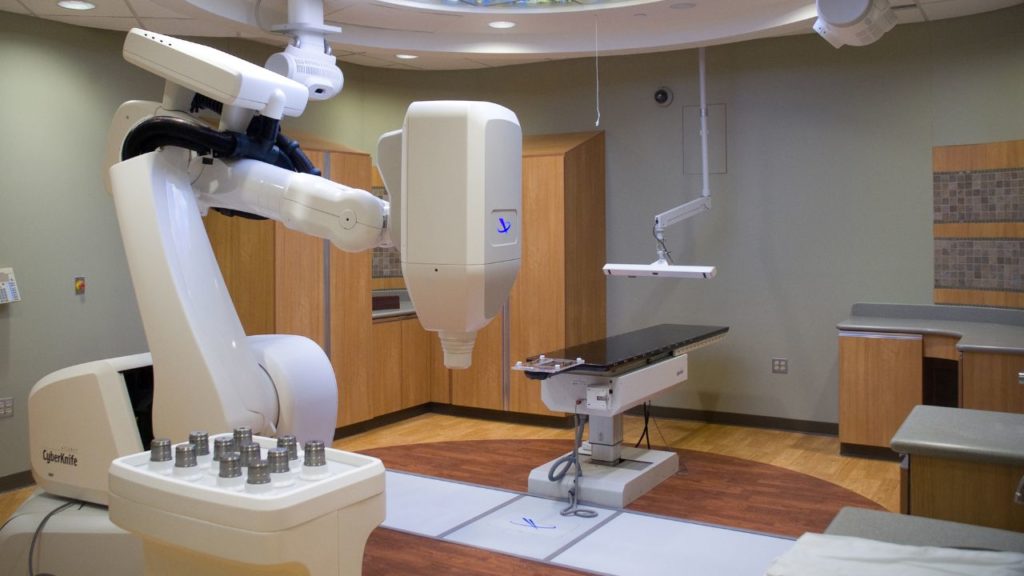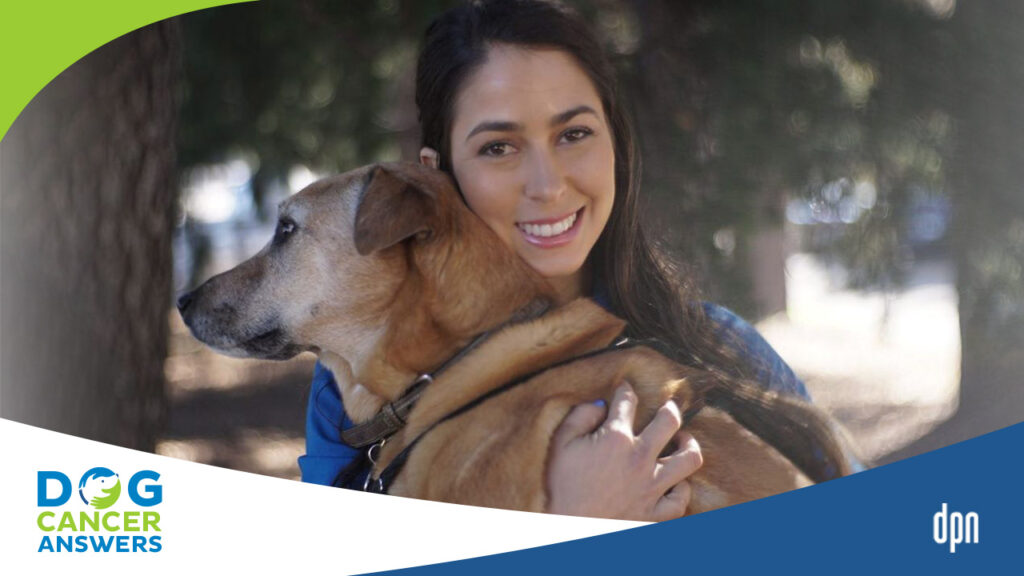EPISODE 202 | RELEASED February 6, 2023
HIFU: How Sound Waves Can Destroy Tumors | Dr. Joanne Tuohy
Use sound waves to make tumors explode with a cloud of tiny bubbles? Check! This experimental therapy may be the future of bone cancer treatment in dogs.
SHOW NOTES
The Virginia-Maryland College of Veterinary Medicine is one of the few locations in the world studying histotripsy, also known as high-intensity focused ultrasound or HIFU. This non-invasive therapy uses powerful sound waves to, well, basically disintegrate tumors. It may sound crazy, but it’s a real thing, and there are even clinical trials in humans ongoing in Spain.
Dr. Joanne Tuohy explains the method and the current studies that she is involved with. Current work is focused on osteosarcoma (bone cancer) and soft tissue sarcoma, but they are hoping to expand to other solid tumors in the future. While we don’t yet know all of the answers and HIFU is far from being considered standard of care for dog cancer, dogs with bone cancer or soft tissue sarcoma may be eligible to participate in clinical trials and receive this therapy.
Links Mentioned in Today’s Show:
Histotripsy for treatment of canine appendicular osteosarcoma clinical trial: https://vetmed.vt.edu/clinical-trials/current-studies/histotripsy-osteo.html
Evaluating the ablative and biomechanical effects of complete tumor histotripsy ablation in canine osteosarcoma clinical trial: https://vetmed.vt.edu/clinical-trials/current-studies/histotripsy-osteo-no-amputation.html
High Intensity Focused Ultrasound (HIFU) ablation as single modality treatment for canine subcutaneous tumors clinical trial: https://vetmed.vt.edu/clinical-trials/current-studies/hifu-sts.html
HeEV: Histotripsy-enabled Extracellular Vesicle characterization in canine soft tissue sarcoma patients clinical trial: https://vetmed.vt.edu/clinical-trials/current-studies/heev-histotropsy-sts.html
[00:00:00] >> Dr. Joanne Tuohy: It causes what we call cavitation, which is these small little micro bubbles that form, and they all form and coagulate and coalesce, and eventually have so much energy built up that they mechanically just break down the tissue right there.
[00:00:22] >> Announcer: Welcome to Dog Cancer Answers, where we help you help your dog with cancer.
[00:00:28] >> Molly Jacobson: Hello, friend. Today on Dog Cancer Answers, we’re learning about an emerging treatment that provides hope for bone cancer and soft tissue sarcoma patients. It’s a non-surgical technique that uses sound waves and tiny bubbles to destroy tumors. It is so interesting. To explain what high-intensity focused ultrasound is and how it works, we’re joined by Dr. Joanne Tuohy at the Virginia Maryland College of Veterinary Medicine at Virginia Tech. She’s a board certified surgeon, but this particular type of treatment does not involve a scalpel.
Dr. Tuohy, thank you so much for being here today.
[00:01:09] >> Dr. Joanne Tuohy: Thank you for having me. It’s an honor to be here.
[00:01:12] >> Molly Jacobson: So tell us what high-intensity focused ultrasound is.
[00:01:16] >> Dr. Joanne Tuohy: Yes. So high-intensity focused ultrasound, as an umbrella term, refers to very specialized ultrasound waves that are being investigated, and in some of its forms used clinically to treat various types of diseases. So cancer is included. And some of the studies that you may have come across have reported its use in people. And um, we currently also have clinical studies, investigative studies, into its use for our veterinary patient.
[00:01:54] >> Molly Jacobson: So I know what an ultrasound is from my own experience of, you know, they put a, a little gel on you, they wave a wand and they can take basically images that sort of look kind of x-ray-ish, but they’re moving, they can see everything. And it’s basically using sound waves to map out the internal soft structures. And is that correct?
[00:02:15] >> Dr. Joanne Tuohy: Yes. So that kind of ultrasound we generally refer to as diagnostic ultrasound.
[00:02:21] >> Molly Jacobson: Uh huh.
[00:02:22] >> Dr. Joanne Tuohy: And so absolutely, those are ultrasound waves. And the reason for the gel is because these ultrasound waves don’t travel as well through air. And so we’ve got that gel that gets squeezed onto us, and that’s to reduce that interface of the air, and so the ultrasound probe can directly be on the gel and image the soft tissue structures and bone as well. So ultrasound can be used, to image bone it is much more challenging. But yes, it’s a very common diagnostic modality.
[00:02:54] >> Molly Jacobson: Okay. But this is something different. This is a treatment modality and it’s using high-intensity focused. So can you explain a little bit about how that changes what we’re thinking of when we think of ultrasound?
[00:03:08] >> Dr. Joanne Tuohy: Yes. So waves come in different wavelengths and durations of waves, different pulses, et cetera. And so with the diagnostic ultrasound waves, the type of waves that are generated by the ultrasound probe are sufficient to enable visualization of the internal structures. But these waves do not have the ability, the energy, to be able to break down or destroy tissue. Which is good, we only want to be looking at them.
We don’t want to do anything hurtful to the tissues. So the focused ultrasound is different in that its purpose is completely different. So we are not using this high-intensity focused ultrasound to look at deep structures just for diagnostic purposes. The purpose of this HIFU is to, at least with what we are doing with our applications in veterinary cancer, is to try and kill the cancer cells.
[00:04:10] >> Molly Jacobson: With sound waves.
[00:04:11] >> Dr. Joanne Tuohy: Yes, exactly. With these ultrasound waves. So it’s the type of wave, it has to be generated by very specialized ultrasound probes. So I couldn’t just go to the diagnostic ultrasound probe, take that and expect that to be able to generate high-intensity sound waves.
[00:04:28] >> Molly Jacobson: Okay, that’s good to hear.
[00:04:29] >> Dr. Joanne Tuohy: Yes. So these are very high-intensity pulses, which can contain a lot of energy. And so when these specialized ultrasound waves get transmitted into the body, there are also ways in which the probe or the transducer, you know, if you think of a diagnostic ultrasound probe, it’s just a single probe we hold in our hand and put it on the body. So these high-intensity focused ultrasound probes are very specialized so that they can focus from various angles almost so to speak.
So they focus onto a single point within the body, whichever our target is, which is usually the tumor. And when there is an accumulation of these sound waves and there is a high enough energy buildup, then it causes what we call cavitation, which is these small little micro bubbles that form, and they all form and coagulate and coalesce and eventually have so much energy built up that they mechanically just break down the tissue right there and disintegrates that tissue.
[00:05:45] >> Molly Jacobson: That’s incredible.
[00:05:46] >> Dr. Joanne Tuohy: Yes. It’s really, the engineering aspects of this are really, it’s very ingenious. And so that’s what we use the HIFU for. So that’s the difference. We don’t use it to visualize and diagnose features or structures. We’re using it specifically to destroy tissue.
[00:06:05] >> Molly Jacobson: That is incredible. With ultrasound waves.
[00:06:08] >> Dr. Joanne Tuohy: Yes.
[00:06:08] >> Molly Jacobson: That are highly focused.
[00:06:10] >> Dr. Joanne Tuohy: Yes.
[00:06:10] >> Molly Jacobson: Okay. So the focusing comes from the special instrument that you’re using that attacks from many different, it doesn’t have a wide field. It’s going very specifically sort of in towards the target, which I assume you’re using some sort of a mapping technology to program the machine. Is it like that, like in radiation where they program it to say, send this laser beam to this point and this other laser beam to that point and kind of get at it from a bunch of angles?
[00:06:39] >> Dr. Joanne Tuohy: Yeah. So I think that’s a really good analogy, radiation treatment. So exactly. The transducer for high-intensity focused ultrasound is controlled by very sophisticated software, as you can imagine. And the treatment planning is done beforehand. So we have CT imaging, for example-
[00:07:00] >> Molly Jacobson: Okay.
[00:07:00] >> Dr. Joanne Tuohy: -for the studies that we are conducting, or MRI imaging.
[00:07:04] >> Molly Jacobson: Okay.
[00:07:05] >> Dr. Joanne Tuohy: And so we already can see the tumor and based on those images, my collaborators are the bio-engineers, they’re amazing bio-engineers, they’re the ones who will then enter that treatment plan that they have designed for each individual patient’s tumor into the software, which then directs that transducer to deliver the focus of the ultrasound waves to exactly where we want it to go. And we can monitor this, this delivery in real time-
[00:07:36] >> Molly Jacobson: Oh wow.
[00:07:37] >> Dr. Joanne Tuohy: -with diagnostic ultrasound imaging, so the other type of imaging that we talked about. And in people, the MRI has also been used to monitor treatments in real time as well. And so yeah, it’s really nice to be able to see, you know, oh gosh, yes, this is, for example, on ultrasound we can see those micro bubbles. We call it the bubble cloud or the cavitation cloud. And it shows up as a white, very bright spot on the ultrasound screen.
[00:08:08] >> Molly Jacobson: That’s incredible. So and ultrasound is a very safe technology for the technician who’s administering it. In diagnostic, ultrasound is a very safe technology. Is this high-intensity focused ultrasound similarly very safe for the people who are administering it, ’cause radiation treatments are not safe for the people who are administering it. But is this safe?
[00:08:33] >> Dr. Joanne Tuohy: Well, so in terms of radiation, ionizing radiation waves, so these ultrasound waves do not have that ionizing radiation. So in that sense, yes. So for example, the people who deliver radiation or do x-rays or do CTs, you know, obviously they have to have guidelines for their own protection.
[00:08:56] >> Molly Jacobson: Right. Step out of the room. And there’s lots of safety protectors for them.
[00:09:00] >> Dr. Joanne Tuohy: Yes.
[00:09:01] >> Molly Jacobson: As well. Yeah.
[00:09:02] >> Dr. Joanne Tuohy: Exactly. But the high-intensity focused ultrasound can be delivered without the people who deliver them needing to step away due to the, any kind of ionizing radiation effect of the waves.
[00:09:15] >> Molly Jacobson: That’s wonderful. So a dog wouldn’t be left alone in a room, even just for a few seconds that they are left alone during, say, a radiation treatment. And we wouldn’t have to worry about the health of the technician who’s delivering, say, chemotherapy is often something that we worry about the long-term side effects for people who are administering chemotherapy. So this is why it’s called non-invasive and non-toxic, right?
[00:09:38] >> Dr. Joanne Tuohy: Well, it’s certainly non-invasive.
[00:09:41] >> Molly Jacobson: Okay.
[00:09:41] >> Dr. Joanne Tuohy: It can be, and non-ionizing, meaning there isn’t radiation. You know, just to be absolutely proper, I think non-toxic might cover too wide of an umbrella.
[00:09:53] >> Molly Jacobson: Okay.
[00:09:54] >> Dr. Joanne Tuohy: Because currently in our clinical trials, which is why they’re clinical trials, we’re trying to find information.
[00:10:00] >> Molly Jacobson: Right. This is not yet available as a treatment that you can just get in your veterinarian’s office at this moment.
[00:10:07] >> Dr. Joanne Tuohy: Correct.
[00:10:07] >> Molly Jacobson: Right.
[00:10:07] >> Dr. Joanne Tuohy: These are not standard of care treatment. So we are still investigating, you know, are there possible side effects of the treatment? So that’s the only reason why I say non-toxic might be a bit too broad of an umbrella.
[00:10:22] >> Molly Jacobson: We don’t quite wanna say that yet.
[00:10:23] >> Dr. Joanne Tuohy: Yes.
[00:10:24] >> Molly Jacobson: Hopefully it will be, but.
[00:10:25] >> Dr. Joanne Tuohy: Hopefully it will be. But certainly non-ionizing, yes, absolutely. It doesn’t have any ionizing radiation associated with it. So for the person delivering, definitely we don’t have to have those kinds of precautions and guidelines in place for protection against ionizing radiation.
[00:10:43] >> Molly Jacobson: So let me ask, when your engineers are programming the HIFU treatment, if there are structures in between the source of the ultrasound waves and the tumor itself, are those impacted as the ultrasound waves go through them, or is there a way to avoid that? Are there certain areas of the body you wouldn’t be able to use this with because it would cause damage on the way in? Like how does that work?
[00:11:08] >> Dr. Joanne Tuohy: Wonderful question. So there are many, kind of, many aspects to the answer to your question, many aspects to your question. So yes, you are absolutely correct. So if we’ve got a tumor that is, let’s say deeper in under the skin, so there is skin, there is um, muscle in the way, maybe some subcutaneous fat in the way. So yes, there are intervening tissues usually. Even if it’s a tumor that’s very superficial in the skin, the skin’s in the way.
[00:11:38] >> Molly Jacobson: Right.
[00:11:39] >> Dr. Joanne Tuohy: So the purpose of this HIFU is to be able to target our treatment such that we do not damage the intervening tissues along the way. So the focus where the ultrasound waves eventually create that cloud of micro bubbles occurs where we want it to occur, which is only in the tumor that we direct it to. So as the ultrasound waves travel, for various reasons, one of which is different tissue types actually have different thresholds, you might think of it, for forming these bubble cloud.
[00:12:20] >> Molly Jacobson: Okay.
[00:12:20] >> Dr. Joanne Tuohy: And so if we can program the threshold to be suitable for just the tumor, that’s one way in which we can avoid damage to intervening structures or innocent bystanders, so to speak.
[00:12:33] >> Molly Jacobson: I wanna make sure I understand what you just said because it truly sounds like science fiction to me, and I wanna make sure that I understood it.
[00:12:39] >> Dr. Joanne Tuohy: Yes.
[00:12:39] >> Molly Jacobson: What I heard you say, is that the sound waves are different wavelengths, different intensities, different patterns, however that works, but they’re different types of ultrasound waves and you can program them so that say, one can be intense enough to affect a bone tumor, but it would not actually affect the skin and the muscles in between because those tissues can simply tolerate that ultrasound wave, whereas the bone tumor couldn’t. Am I getting that right?
[00:13:10] >> Dr. Joanne Tuohy: Yes, I believe so. So it’s not so much that they’re different types of waves as they travel through the different tissues. It’s the same waves.
[00:13:20] >> Molly Jacobson: Right.
[00:13:20] >> Dr. Joanne Tuohy: It’s the different tissues’ thresholds, if you wanna think of it that way. So different tissues will have different thresholds at which the high-intensity focused ultrasound waves will adversely affect them. And just to give you an example, and this information has been published in a recent paper, where we use the same, quote unquote, dose of this focused ultrasound, the HIFU, and this is a non-thermal type of HIFU.
[00:13:50] >> Molly Jacobson: Okay, so non heat, it’s not hot.
[00:13:52] >> Dr. Joanne Tuohy: Not heat, yes.
[00:13:53] >> Molly Jacobson: Okay.
[00:13:53] >> Dr. Joanne Tuohy: High-intensity focused ultrasound can come in two big categories. One is destroying tissue by heat.
[00:13:59] >> Molly Jacobson: Uh huh.
[00:14:00] >> Dr. Joanne Tuohy: And then the non-thermal kind, which is what I’ve been describing to you. And I apologize for not making that clear. This is the way in which we destroy tissue with this type of non-thermal HIFU-
[00:14:12] >> Molly Jacobson: Okay.
[00:14:12] >> Dr. Joanne Tuohy: -by creating the micro bubbles and disintegrating the tissue.
[00:14:16] >> Molly Jacobson: Uh huh.
[00:14:17] >> Dr. Joanne Tuohy: Versus the thermal HIFU, which are again, a different wavelength, different type of ultrasound wave. That type of HIFU destroys tissue and cells with heat by thermal methods. So.
[00:14:28] >> Molly Jacobson: Okay.
[00:14:28] >> Dr. Joanne Tuohy: This is non-thermal HIFU. And so now let me go back to where I was talking about the manuscript data where we used the same dose of non-thermal HIFU, or it’s called histotripsy.
[00:14:41] >> Molly Jacobson: Okay.
[00:14:41] >> Dr. Joanne Tuohy: That we established a dose that would break down the bone cancer cells, and we used that same dose, so to speak, to target a normal bone tissue and normal nerves-
[00:14:56] >> Molly Jacobson: Okay.
[00:14:56] >> Dr. Joanne Tuohy: -and show that, at least when a pathologist looks at the tissue under the microscope, the non-thermal HIFU or histotripsy does not appear to damage that tissue.
[00:15:10] >> Molly Jacobson: This is incredible. So you’re saying this treatment, hIFU, non-thermal, can destroy that bone tumor but not the bone surrounding it?
[00:15:19] >> Dr. Joanne Tuohy: Right. If it’s a, a normal bone. So for example, one of the really exciting potential for how precise we can make this non-thermal HIFU treatment is how we can avoid big blood vessels, for example. Critical structures that we don’t want to hurt or traumatize.
[00:15:42] >> Molly Jacobson: Right.
[00:15:42] >> Dr. Joanne Tuohy: So for example, in liver tumors, the liver is full of big blood vessels. So the use of these non-thermal HIFU strategies, with its precision, we can treat liver tumors and be able to spare damage to the blood vessels that might be running close by.
[00:16:05] >> Molly Jacobson: That’s incredible.
[00:16:06] >> Dr. Joanne Tuohy: Yeah, and very, and very recently, within the last month or so, the first paper just got published for use of this non-thermal HIFU or histotripsy for use in a clinical trial in people for treating liver tumors in people in Spain. Very exciting report.
[00:16:25] >> Molly Jacobson: So what happens after the bubble cluster forms and the tumor is destroyed? What happens to that destroyed tumor, how does the body manage that? Are there side effects to this, is there damage that the dog or the human feels as a result of this treatment?
[00:16:43] >> Dr. Joanne Tuohy: That’s a great question. Another great question. And I think that there are, of course, unknowns. You know, it’s such a new technology. We don’t have all the answers.
But what I can report to you is that with some of the preclinical studies that have been done with the breakdown of the tumor by this HIFU, for one, we theorize – and we have some of this preclinical data to support our hypotheses – is that the tumor now is broken down and so fragments of the tumor are now available for the immune cells to recognize them and be able to mount a better immune response against the tumor.
So these are the host, the patient’s own immune cells. So that is one downstream effect that we are hoping we can see with the use of this technology. We see it in our preclinical data in the study that was reported in Spain.
[00:17:46] >> Molly Jacobson: Uh huh.
[00:17:46] >> Dr. Joanne Tuohy: You know, this is in patients, clinical patients, so we have data based off of sequential MRI imaging.
[00:17:53] >> Molly Jacobson: Okay.
[00:17:54] >> Dr. Joanne Tuohy: So I couldn’t tell you molecularly what was happening to the tumor.
[00:17:57] >> Molly Jacobson: Right. This is all visual.
[00:17:59] >> Dr. Joanne Tuohy: Yes. But it shows that the tumors that were treated, they had decreased in size, and also in one of the patients, one of the other tumors that was not treated appeared also to be decreasing in size. So suggesting that maybe there is truly some kind of immune response. We don’t know that for sure.
[00:18:23] >> Molly Jacobson: Right.
[00:18:24] >> Dr. Joanne Tuohy: But some of these early, very preliminary observations that have been made are exciting. So we don’t know for certain, you know, I couldn’t make a statement we will stimulate that immune response and have a great anti-cancer response from the immune system. But our early preclinical as well as preliminary data that we’re seeing, for example, out of this study in Spain, is exciting, it suggests that there is a chance that the immune system can be stimulated by these tumor fragments that get released.
[00:18:55] >> Molly Jacobson: That’s very exciting, and it makes sense because obviously when the tumor breaks up, the immune system doesn’t just fight cancer, it also cleans up messes in the bodies.
[00:19:06] >> Dr. Joanne Tuohy: Right.
[00:19:06] >> Molly Jacobson: You know, like it heals things. So it goes, oh.
[00:19:08] >> Dr. Joanne Tuohy: Right.
[00:19:08] >> Molly Jacobson: There’s something over there that needs to be healed or addressed or cleaned up, it goes over there, says, oh my word – I’m personifying the immune system as if it’s a person, but oh my goodness, there’s all of these little tumor fragments, we better inspect the area and mount a defense and make sure we clean this up really well.
So I can see how logically, from a biological basis, it makes sense that this might be something that’s happening. You go in there, you ablate a tumor, and all the other tissues are normal, and it sort of says to the immune system, there’s a problem, but it’s not everywhere. It’s right here. It sort of tags that spot.
[00:19:43] >> Dr. Joanne Tuohy: Yes.
[00:19:43] >> Molly Jacobson: This is so exciting. I imagine that a dog would need to have anesthesia in order to stay really still so that waves go where you want them to go. Is that right?
[00:19:54] >> Dr. Joanne Tuohy: Exactly, exactly.
[00:19:55] >> Molly Jacobson: Yeah.
[00:19:55] >> Dr. Joanne Tuohy: It’s a light anesthesia, just like we would give to a dog who has to undergo a CT or an MRI scan.
[00:20:02] >> Molly Jacobson: Oh, okay. So it’s not general anesthesia?
[00:20:04] >> Dr. Joanne Tuohy: It is general anesthesia.
[00:20:05] >> Molly Jacobson: Okay.
[00:20:06] >> Dr. Joanne Tuohy: But we just need a patient to lay still. It’s just not deep, you know, versus surgical anesthesia, when I do surgery, I need my patient to be deep under anesthesia. So this is a light anesthesia because just like when we give radiation treatment to a, a dog or a cat, we can’t afford for them to move because we don’t want to radiate the wrong spot.
[00:20:29] >> Molly Jacobson: Right.
[00:20:29] >> Dr. Joanne Tuohy: And so similarly, we can’t have them move so that we don’t accidentally treat the wrong spot that we don’t intend to treat. So yes, they do have to undergo a general anesthesia.
[00:20:40] >> Molly Jacobson: How long does the treatment take?
[00:20:43] >> Dr. Joanne Tuohy: So, at the moment, with our early studies that we have, treatment of a bone tumor, for example, osteosarcoma, for about, you know, a pretty small volume of tumor, we are probably looking at about a 30 minute treatment.
[00:21:03] >> Molly Jacobson: 30 as in three zero. Half an hour.
[00:21:05] >> Dr. Joanne Tuohy: Yep. Half an hour. So that’s one of the areas of investigation that we are pursuing, which is, well, the general we, which is mostly our bio-engineering collaborators because it’s much more based in bioengineering, is to design these transducers and the whole histotripsy or the HIFU delivery system to decrease the delivery time so that eventually we can treat larger and larger tumors.
[00:21:36] >> Molly Jacobson: Oh, because is it the anesthesia that’s limiting the amount of time you can spend in the treatment? Or is it-
[00:21:42] >> Dr. Joanne Tuohy: Yeah, because, um, you know, as much as possible I would like to avoid having patients under general anesthesia for extended, for long, long periods of time. And so it’s a balance between, you know, if the benefits, pros and cons of a treatment, we have to strike a nice balance with that.
[00:22:01] >> Molly Jacobson: Right.
[00:22:02] >> Dr. Joanne Tuohy: And so ideally, our treatment times will be as short as possible to limit the amount of time a patient may be under anesthesia. The anesthesia, we can’t help. We can’t help it. They have to have it. But we’d like to shorten the time.
[00:22:17] >> Molly Jacobson: Do humans have to have anesthesia?
[00:22:19] >> Dr. Joanne Tuohy: So it depends on the application of the HIFU, because thermal HIFU has been used in some instances as well in people for various applications. And I think it varies. So for some applications they do have patients, human patients, under anesthesia, and in some applications they don’t necessarily need it.
[00:22:40] >> Molly Jacobson: Okay. Is this like a one and done deal? Like if we have a small tumor that you feel confident you can ablate in 30 minutes, do they have to come back? Is it a one-time treatment?
[00:22:51] >> Dr. Joanne Tuohy: So another wonderful question. I am afraid I can’t give you an answer to that right now because our studies are so preliminary. I wish I could.
[00:23:00] >> Molly Jacobson: Uh huh. Right.
[00:23:01] >> Dr. Joanne Tuohy: But we hope that that will be the case. But it may be that, you know, with, at least in the early stages of the technology, we may have to split treatments up for very large tumors.
[00:23:16] >> Molly Jacobson: Sure.
[00:23:17] >> Dr. Joanne Tuohy: Because unfortunately, there are cats and dogs that come to us with very substantially sized tumors. And so for those, it may be much more viable and feasible for the patient to carry out the treatment in various stages. Because it’s not just the anesthesia at that point, but also the potential for too much tumor cell death all at once.
[00:23:43] >> Molly Jacobson: Uh huh.
[00:23:43] >> Dr. Joanne Tuohy: Which can be overwhelming for the body, for the immune system, for the patient. So I think a staged treatment could be a possible option in the future.
[00:23:54] >> Molly Jacobson: Well, that leads me to a really important question. I know our listeners will wanna know if their dogs are going to feel pain as a result of HIFU.
[00:24:02] >> Dr. Joanne Tuohy: Yeah, that’s uh, another great question. So we don’t know definitively.
[00:24:09] >> Molly Jacobson: Okay.
[00:24:09] >> Dr. Joanne Tuohy: What is being done in people, with thermal HIFU, is some people with bone lesions – and it could be benign lesions or metastatic bone lesion, bone tumors – thermal HIFU has been given to people for alleviation of bone pain.
[00:24:29] >> Molly Jacobson: Oh.
[00:24:30] >> Dr. Joanne Tuohy: Yeah. And so based on that information, we are hopeful that our veterinary patients at least, you know, in the specific tumor where I’m investigating, which is bone tumor osteosarcoma, that we can actually provide some pain alleviation and pain palliation, because otherwise the treatment will not be viable as a limb salvage treatment. Because I could use the ultrasound to destroy cancer cells, but if it causes pain to a degree where it’s, um, not just maybe transient or temporary, you know, when we have surgery, we have some post-surgical pain that resolves with pain medication, et cetera.
[00:25:12] >> Molly Jacobson: Sure.
[00:25:12] >> Dr. Joanne Tuohy: But if we cause an unacceptable level of pain with the treatment, then it’s not a viable treatment.
[00:25:17] >> Molly Jacobson: Yeah. People won’t do it.
[00:25:19] >> Dr. Joanne Tuohy: Right. And I wouldn’t do it for anyone.
[00:25:21] >> Molly Jacobson: Right.
[00:25:22] >> Dr. Joanne Tuohy: So that’s another important piece of information that we need. And so we have a clinical study that will open probably early next year for dogs with osteosarcoma, and it’s um, for owners who have elected to decline all other standard treatments.
[00:25:45] >> Molly Jacobson: Okay. So they’re not gonna get an amputation.
[00:25:47] >> Dr. Joanne Tuohy: Right.
[00:25:48] >> Molly Jacobson: They’re not gonna do chemotherapy.
[00:25:49] >> Dr. Joanne Tuohy: Right.
[00:25:50] >> Molly Jacobson: Those dogs could enroll in this study.
[00:25:53] >> Dr. Joanne Tuohy: Correct. Right. They’re not getting radiation, they’re not getting surgery. Essentially, because this is not a standard of care therapy, we couldn’t enroll dogs whose owners are interested in standard of care therapy because it’s not.
[00:26:06] >> Molly Jacobson: Right.
[00:26:06] >> Dr. Joanne Tuohy: So it’s only for owners who have declined other therapies, standard therapies for their dogs, and they can enroll in this trial where one of the goals for this trial is to find out what degree of pain alleviation, if any, these dogs experience after histotripsy ablation of their osteosarcoma tumors.
[00:26:28] >> Molly Jacobson: Wonderful.
[00:26:29] >> Dr. Joanne Tuohy: Yeah. So we’ll evaluate these dogs with various modalities, such as, uh, we’ll give owners questionnaires, we’ll walk the dogs over a gait analysis mat, et cetera, to try to assess the level of pain relief that we hopefully are providing.
[00:26:46] >> Molly Jacobson: Well, that would be sort of a miracle upon a miracle to have a noninvasive technique that addresses the tumor deep in the body without having to open the body up, and then also provides pain relief as a result of the treatment, and stimulates the immune system. That’s all very, very exciting. So right now you’re working with osteosarcoma?
[00:27:11] >> Dr. Joanne Tuohy: Yes.
[00:27:12] >> Molly Jacobson: Are there any other cancer types that you envision would be able to take advantage of this perhaps later?
[00:27:19] >> Dr. Joanne Tuohy: Yes, absolutely. So a couple of my colleagues have been investigating the use of HIFU for soft tissue sarcomas in dogs and, um, more recently also in feline injection site associated sarcoma.
[00:27:36] >> Molly Jacobson: Oh, wow. That’s big, right?
[00:27:37] >> Dr. Joanne Tuohy: Yeah. Yeah.
[00:27:39] >> Molly Jacobson: I don’t have a cat, but I have lots of cat lovers in my life and this is something that’s very upsetting for them when it happens.
[00:27:45] >> Dr. Joanne Tuohy: Right, right.
[00:27:46] >> Molly Jacobson: That sarcoma.
[00:27:47] >> Dr. Joanne Tuohy: Because it’s a very locally aggressive disease, so, absolutely. Yeah. So my colleagues are doing that, and I think that down the road in the near future, you know, we can think about investigating HIFU or histotripsy for say, liver tumors like they have in people. And I think there can be other tumor types that we can think about exploring with this modality. And so the important thing is to gather the preliminary information so that we have a data set off of which we can then say, well, can we investigate this in this tumor type, for example.
[00:28:29] >> Molly Jacobson: Right. What about hemangiosarcoma? Are you, is that on your radar? I know that’s a big one for a lot of our listeners.
[00:28:36] >> Dr. Joanne Tuohy: Of course. Hemangiosarcoma is, yes, I understand, it’s um, it’s such a devastating tumor.
[00:28:43] >> Molly Jacobson: So aggressive and bloody.
[00:28:45] >> Dr. Joanne Tuohy: Yes. Yes. Very, very aggressive. And so, you know, it’s hard for me to project down the road.
[00:28:54] >> Molly Jacobson: Sure.
[00:28:54] >> Dr. Joanne Tuohy: But immediately my personal opinion is that it wouldn’t be the first tumor I would reach for, to do early studies with using HIFU.
[00:29:06] >> Molly Jacobson: Okay.
[00:29:07] >> Dr. Joanne Tuohy: Because of the blood content in these tumors, the fluid content can be very challenging, and also, you know, potentially risky.
[00:29:18] >> Molly Jacobson: You’d be destroying a tumor that’s in the lining of a blood vessel. So that hole you create in the blood vessel might cause an internal bleed.
[00:29:26] >> Dr. Joanne Tuohy: Right, right.
[00:29:27] >> Molly Jacobson: Okay.
[00:29:27] >> Dr. Joanne Tuohy: And so I think that, you know, that’s just the clinician side of me talking.
[00:29:33] >> Molly Jacobson: Yes.
[00:29:33] >> Dr. Joanne Tuohy: We don’t have the data because we haven’t investigated the use of it in hemangiosarcoma, but you know, just the clinician side of me is hesitant to at least start with that. Who knows where we’ll get to in the future.
[00:29:46] >> Molly Jacobson: Sure. There might be another way of addressing that as you’ve become more confident in the use of HIFU in other cancer types, then other things can come in and be addressed that would make it more widely available.
[00:29:58] >> Dr. Joanne Tuohy: Potentially. Yeah, absolutely. And with technology, technology advances so quickly.
[00:30:04] >> Molly Jacobson: Right.
[00:30:04] >> Dr. Joanne Tuohy: And so I think on the engineering side, you know, if we’ve got technology that eventually develops that could be suitable, then, you know, I think that it’s unknown where we can go with this, and I think it’s exciting, but that’s probably not one I would start with.
[00:30:21] >> Molly Jacobson: That makes sense to me. We’re going to take a short break and when we return, I want to get into aftercare for this treatment.
And we’re back with Dr. Tuohy discussing her work with HIFU or high-intensity focused ultrasound. Dr. Tuohy, is there any aftercare people need to be prepared for?
[00:30:42] >> Dr. Joanne Tuohy: So I am most intimately aware of the data from my clinical trial with osteosarcoma patients. And so they do not so far appear to need any aftercare in so far as, you know, I do not have long-term data because right now our clinical trial is structured so that our dogs receive the histotripsy treatment to their tumor and they receive an amputation either 24 hours or three or five days after treatment.
And so the timeline is very short. But what we have noted is that they do not seem to need extra pain medication or extra care after the histotripsy. And this is purely anecdotal, so I have to stress, it’s purely anecdotal, but I’ve had, um, a couple of owners mention to me that they felt that their dogs seemed to be bearing more weight on that leg after the histotripsy. But that is very subjective and very anecdotal.
[00:31:48] >> Molly Jacobson: Right.
[00:31:49] >> Dr. Joanne Tuohy: But we haven’t had any needs for extra pain medications or anything like that so far.
[00:31:55] >> Molly Jacobson: So you mentioned that afterwards dogs are getting amputations. Is that so that you can give the treatment, give it a few days, and then have the leg taken off so they get their standard of care treatment for osteosarcoma, and then you have the tumor that you can examine and see how that treatment affected it?
[00:32:14] >> Dr. Joanne Tuohy: Correct. Yes, absolutely. This clinical trial is set up so it doesn’t interfere with a dog’s ability to receive standard of care treatment.
[00:32:24] >> Molly Jacobson: Okay. That’s nice.
[00:32:26] >> Dr. Joanne Tuohy: And so that’s why we only enroll dogs whose owners have elected for that.
[00:32:31] >> Molly Jacobson: Right.
[00:32:31] >> Dr. Joanne Tuohy: For standard of care. And you’re right. After we amputate the limb, our pathologist collaborator, of course, obtained cell samples for a diagnosis for the owner, but also, we’ll assess the areas where we have treated with histotripsy to assess what happens to the cells. Are we destroying the cells, are the immune cells moving into the tumor more than we would have expected, for example. So those are the assessments we can make with the tumor after it’s removed by the limb amputation.
[00:33:05] >> Molly Jacobson: So is this the only study where people could participate at this point? If someone wanted to try this with their dog, would they contact you to enroll in that study and or the study next spring in 2023?
[00:33:18] >> Dr. Joanne Tuohy: Yes, they’re very welcome to contact me or our clinical trials office.
[00:33:23] >> Molly Jacobson: Okay.
[00:33:23] >> Dr. Joanne Tuohy: Mindy Quigley is our clinical trials coordinator, and she’s wonderful at giving clients information about studies. And so for osteosarcoma and histotripsy, yes, I would be the primary contact. But for a client who might be interested in HIFU or histotripsy for soft tissue sarcomas, they certainly can contact our clinical trials office. So again, our clinical trials coordinator will direct them to the principal investigators for those studies as well.
[00:33:54] >> Molly Jacobson: Wonderful. We’ll put the links to everything in the show notes so people can get it easily. I have two more questions. Do you have evidence of, or do you know yet whether tumors tend to recur using this treatment?
[00:34:06] >> Dr. Joanne Tuohy: So for my studies, and I can only speak for them, that is not part of our assessment because the limbs get amputated.
[00:34:15] >> Molly Jacobson: Uh huh.
[00:34:16] >> Dr. Joanne Tuohy: So we do not know whether the tumors would recur after histotripsy treatment.
[00:34:22] >> Molly Jacobson: Right.
[00:34:23] >> Dr. Joanne Tuohy: But that is a very important question to answer. There are many questions we need to answer down this path before we can establish it as a standard of care. But yes, you hit the nail in the head. That’s an important question.
[00:34:38] >> Molly Jacobson: Yeah. So if someone wanted to get this treatment and they were accepted into your trial, what’s the estimated out-of-pocket cost for that client?
[00:34:49] >> Dr. Joanne Tuohy: Good question. So the clinical trial provides financial credit to the client of $2,000 towards the cost of a limb amputation surgery. And typically for a very general estimate with us, the limb amputation surgery is somewhere between $3,500 and $4,500, typically.
[00:35:12] >> Molly Jacobson: Okay.
[00:35:12] >> Dr. Joanne Tuohy: And so, you know, for the treatment part, that is the client’s kind of estimated out of pocket, which is the $3,500 to $4,500 minus $2,000.
[00:35:22] >> Molly Jacobson: Okay.
[00:35:22] >> Dr. Joanne Tuohy: In order to qualify for the trial, a dog has to be determined to be free of metastatic disease.
[00:35:29] >> Molly Jacobson: Okay.
[00:35:30] >> Dr. Joanne Tuohy: And the determination can be made by chest x-rays, which is the responsibility of the owner.
[00:35:36] >> Molly Jacobson: Sure. They’ve often gotten those before they think about entering a clinical trial because they’ve been trying to figure out what’s going on with their dog. And so they’ve probably already got those chest x-rays and have that before they enroll. They know.
[00:35:48] >> Dr. Joanne Tuohy: Well, it depends.
[00:35:50] >> Molly Jacobson: Okay.
[00:35:50] >> Dr. Joanne Tuohy: We actually get a fair number of owners who decide they would rather just kind of get all their diagnostics done with us at the initial appointment, which they’re very welcome to do. So we can do that for them. And we also offer full body CT scans-
[00:36:05] >> Molly Jacobson: Uh-huh.
[00:36:06] >> Dr. Joanne Tuohy: -for the interested owner because for osteosarcoma, unfortunately, it likes to metastasize to the lungs.
[00:36:14] >> Molly Jacobson: Yeah.
[00:36:14] >> Dr. Joanne Tuohy: But also it can metastasize to other bones.
[00:36:18] >> Molly Jacobson: Right.
[00:36:18] >> Dr. Joanne Tuohy: And so it’s a low percentage, at the moment, you know, we’re estimating maybe 8%, eight, 10% of the time. And so the full body CT we can see from head to toe.
[00:36:29] >> Molly Jacobson: Right.
[00:36:30] >> Dr. Joanne Tuohy: Basically. And so owners can elect to do that as well. And if an owner elects to do that for their dog, and then subsequently they end up enrolling their dog in the study, we will credit the owner with $700 towards that CT scan cost as well.
[00:36:48] >> Molly Jacobson: Okay. So when, crossing fingers, these are out of trials-
[00:36:53] >> Dr. Joanne Tuohy: Uh-huh.
[00:36:53] >> Molly Jacobson: -and you and your colleagues have established this as safe and, and becomes a standard of care, is this a technology that will need to be in a large specialty hospital, is the equipment very expensive, how much do you think it will cost? Is it gonna be comparable to radiation? I know I just asked a lot of questions, but they’re sort of all the same thing.
[00:37:12] >> Dr. Joanne Tuohy: Yes.
[00:37:13] >> Molly Jacobson: If this comes true, how much are we gonna be paying for it?
[00:37:16] >> Dr. Joanne Tuohy: Right. Right. And I honestly do not know, but yes, in the foreseeable future, at least when we, you know, if we first introduce this technology, it will only be available at very select places that have the ability to have the equipment and also the expertise to deliver it. But all of the specialized equipment and expertise, they have to start somewhere. I imagine when radiation treatment first started, and this is just in my imagination, it probably started also small and then we start growing it.
[00:37:54] >> Molly Jacobson: Yeah.
[00:37:55] >> Dr. Joanne Tuohy: So the machines and the, and the radiation oncologists, we start to grow that population more and so it’s more readily available by the year. And so I would envision that this technology would go the same way, a very similar way. We have to start it at probably very limited number of institution or high-end referral specialty clinics with the ability and the personnel to deliver it. That’s my prediction. And then maybe grow it. As far as cost, unfortunately, I, I do not have a clue.
[00:38:30] >> Molly Jacobson: There’s so many factors that go into cost.
[00:38:32] >> Dr. Joanne Tuohy: Yes.
[00:38:33] >> Molly Jacobson: For any treatment, for sure. My last question is, about HIFU or any other topic, is there anything that you want to say directly to our listeners who are facing dog cancer? Is there any, like what’s your biggest piece of advice?
[00:38:48] >> Dr. Joanne Tuohy: Well, I think that it’s always good for all of us as pet owners and as maybe, you know, I hope it never happens, but as patients or family members of patients – you know, in, in medical care and in veterinary care, I think, you know, it’s always good to kind of be open to exploring different options and then seeking opinions from your doctor, or if you know your doctor needs to then make a referral be open to that as well.
And for owners who are interested in clinical trials to look at websites. Usually they are occurring at universities. So looking at websites of various universities. There are many trials ongoing at the big veterinary teaching hospitals for osteosarcoma and different cancers. And so I think that just seeking information and then talking to your doctor and, you know we can get all kinds of information from the web.
[00:39:46] >> Molly Jacobson: Right.
[00:39:47] >> Dr. Joanne Tuohy: But seeking to to kind of distill that information to what is helpful to my own pet, for example, if I were an owner, would be important.
[00:39:55] >> Molly Jacobson: Yes. That’s one of our goals here, is to take all of the information out there and filter it through the greatest minds in veterinary science and make sure that everybody understands it clearly and then can speak to their own veterinarian in order to see if it works or would apply in their dog’s situation. Because everybody’s case is so different.
[00:40:16] >> Dr. Joanne Tuohy: Exactly.
[00:40:16] >> Molly Jacobson: And there’s no one size – I really wish there were. I wish I had a magic wand.
[00:40:21] >> Dr. Joanne Tuohy: Right.
[00:40:21] >> Molly Jacobson: And then I wish that this was a technical challenge. I like to say cancer is not a technical challenge, it’s an adaptive challenge. It changes and we have to change in order to address it. And it’s not straightforward. And I wish it were.
[00:40:34] >> Dr. Joanne Tuohy: I wish it were too. But yes, it’s a very complex disease, cancer.
[00:40:38] >> Molly Jacobson: Yes, and that’s one of the reasons I’m excited about the research you’re doing because it actually feels closer to a technical solution than a lot of other treatments. The idea that you could do something that would destroy the tumor, stimulate the immune system, provide pain relief, and then possibly not have a lot of side effects, like other treatments can have a lot of side effects. That’s pretty close to ideal cancer treatments.
[00:41:08] >> Dr. Joanne Tuohy: Well, that’s always our hope.
[00:41:10] >> Molly Jacobson: Right.
[00:41:10] >> Dr. Joanne Tuohy: But I do think that realistically, cancer being such a complex disease, will, most likely for the foreseeable future we are, we are looking at multimodal therapy. So I would love histotripsy to be able to accomplish everything and be the cure-all, or focused ultrasound, but I think that to maximize treatment impact for our patients for best outcomes, I think we’re probably still looking at multimodal therapy. So maybe histotripsy or focused ultrasound combined with another immunotherapy.
You know, combination therapy is important because cancer, it’s not just one molecule.
[00:41:52] >> Molly Jacobson: Right.
[00:41:53] >> Dr. Joanne Tuohy: Or one receptor. So I think there’s always going to be a team effort in trying to treat cancer.
[00:42:00] >> Molly Jacobson: Yes, 100%. And that’s why it’s important to have excellent team members that you trust. And um, I’m really glad that you came on our show today to speak to our listeners and I want you to come back when you have more news about HIFU. Will you do that?
[00:42:17] >> Dr. Joanne Tuohy: Thank you. I would love to.
[00:42:19] >> Molly Jacobson: I would love to hear how things go.
[00:42:22] >> Dr. Joanne Tuohy: Thank you. Thank you so much.
[00:42:26] >> Molly Jacobson: And thank you listener. High-intensity focused ultrasound may not be widely available right now in early 2023, but clinical trials like the ones Dr. Tuohy’s working on will help to answer questions we still have about this therapy and hopefully bring it to veterinary hospitals near you.
Check out the show notes for links to learn more about the current clinical trials and be sure to visit us on dogcancer.com to find more exciting treatments that are in the wings. If your dog’s been enrolled in a clinical trial, we would love to hear from you about your experience. You can leave a message on our Listener Line at (808) 868-3200, and we’ll get back to you to feature your dog on a future episode.
I’m Molly Jacobson, and from all of us here at Dog Podcast Network, I’d like to wish you and your dog a very warm, Aloha.
[00:43:20] >> Announcer: Thank you for listening to Dog Cancer Answers. If you’d like to connect, please visit our website at dogcanceranswers.com or call our Listener Line at (808) 868-3200. And here’s a friendly reminder that you probably already know: this podcast is provided for informational and educational purposes only. It’s not meant to take the place of the advice you receive from your dog’s veterinarian.
Only veterinarians who examine your dog can give you veterinary advice or diagnose your dog’s medical condition. Your reliance on the information you hear on this podcast is solely at your own risk. If your dog has a specific health problem, contact your veterinarian. Also, please keep in mind that veterinary information can change rapidly, therefore, some information may be out of date.
Dog Cancer Answers is a presentation of Maui Media in association with Dog Podcast Network.
Hosted By
SUBSCRIBE ON YOUR FAVORITE PLATFORM
Topics
Editor's Picks
CATEGORY










